Abstract
The topic of diffuse pollution is of particular interest from technical, scientific, and administrative management points of view. Diffuse pollution is defined as the contamination or chemical, physical, or biological alterations of environmental matrices caused by diffuse sources and not attributable to a single origin. In this study, various sources of diffuse pollution such as nitrates, pesticides, metals, and plastics were analysed. This was aimed at the implementation of a decision support system able to represent the state of environmental matrices degradation, with particular attention to water resources, and to make decisions evaluating similar environmental contexts. The potential of the developed system makes it possible to identify areas with the same environmental characteristics, referring to the various activities that create diffuse pollution and areas with the same pressure values on the environmental matrices. The system provides the political decision-maker with greater awareness of the environmental state, thus enabling him to apply more accurate land management policies. The created system, based on open-source software, which can be implemented with additional available data sources, is characterised by a data processing workflow that provides output information at the municipal level, so that it can be managed both by mayors and regional managers who are able to share the same information with all.
1. Introduction
The Puglia region (south-eastern Italia peninsula) is ruled by a flat and hilly territory, with a coastline 800 kilometres long between the Adriatic and Ionian Seas. The territory is mainly karstic [1]. It is characterised by a wealth of water resources, mainly underground [2]. The water resources to be safeguarded in Puglia include mainly aquifers, rivers, many lakes, and artificial basins. As for surface water resources, among the main streams are the Ofanto, one of the longest rivers in southern Italy, the Cervaro, the Fortore, the Bradano, and the Basento. Among the lakes stands out Lesina Lake, located in the coastal plain of Tavoliere, characterised by an important bird and fish fauna. The territory of the Puglia region and the environmental matrices are constantly under pressure due to numerous factors. The results of regional monitoring of underground rivers and aquifers indicate the presence of several threats [3,4].
There is a need to implement specific actions to combat the depletion of water resources. Biological, physical, and chemical factors can compromise a water body compared to its beneficial use, generating a condition of contamination or degradation. The extent of pollution depends on the pollutant, the type of water body, its location, and the benefits it brings. Natural events, able to compromise the balance of water ecosystems, can occur but in most cases, the pollution arises from anthropogenic activities.
Major threats include widespread pollution of pesticides (PPPs), nitrates of agricultural and livestock origin, heavy metals, and plastics. Agriculture has a significant impact, with millions of tons of PPPs applied to increase the yield and quality of crops [5,6]. Pesticide pollution occurs when they are used on fields, presumably in larger quantities than the recommended doses [7,8,9]. The use of these substances leads to an accumulation in soils and water, damaging the environment and human health. Widespread pollution from agricultural nitrates occurs when there is excessive use of nitrogen fertilizers in cultivated fields [10,11,12]. Also, in this case, the excess of nitrates in the aquatic ecosystems can compromise water quality, causing eutrophication [13]. Further pollution is from heavy metals in both soil and groundwater. This is due to the use of fertilisers [14] or the improper storage of contaminated materials.
Surface and deep-water bodies can be exposed to contaminants through different pathways and mechanisms. Sources of pollution can be widespread and appear suddenly. The first are those spread over a large geographical area and are difficult to identify and mitigate, also called nonpoint sources of pollution. Point sources are areas where contamination can be defined and the source of contamination identified. These are sites characterised by the presence of mines, industries, refineries, and in the case of natural causes, also algal blooms.
The massive use of pesticides is necessary to safeguard crops in agriculture. This involves their continuous release of substances into surface and groundwater through drainage, runoff, and leaching processes. This implies the need for their constant monitoring due to toxicity as a parent compound or metabolite [9]. Furthermore, the incorrect use and mismanagement of fertilizers in agriculture result in a form of water pollution that should be monitored [15]. Surface runoff and drainage can bring PPPs into surface water bodies from agricultural fields, where more soluble molecules can be transferred more easily by runoff during a rain event or by irrigation. The less soluble molecules may be more persistent because they bind to soil particles and/or sediment. However, during stormy phenomena, these hydrophobic compounds can be carried into the water due to the displacement of soil particles or the mixing of sediments [16].
Pesticides, nitrates, and heavy metals can also be a source of point pollution in cases of waste abandonment and illegal disposal such as the unauthorised landfill of waste. In this case, it also generates diffuse pollution by microplastics as the plastic is disintegrated by atmospheric agents into microscopic particles and spreads into the surrounding environment [17,18].
Illegal landfills are a serious environmental problem in many parts of the world [19,20,21]. These are illegally created landfills, without complying with waste management regulations and without the necessary permits. These landfills can be found in many parts of the world, even in developed countries where waste collection is properly managed. Usually, illegal landfills occur in rural areas where it is difficult to carry out capillary control by the local authorities. Abandoned mining sites such as quarries are often ideal sites for waste disposal [22,23,24]. Quarries can have significant effects on hydrographic regime modelling, mostly in karst areas. These include alteration of drainage, changes in groundwater level, and effects on soil erosion. Limestone quarries can alter the hydrogeology of the territory and the groundwater flow paths [25]. The extraction zones evolve into a well that quickly conveys surface water to the groundwater system. Mechanical extraction methods are used in the region, and the use of explosives is limited. Quarry blasting, the process of using explosives to break rocks, can cause disruption and changes in the pattern of groundwater flow paths [26]. A detailed hydrogeological study was performed in a fractured carbonate rock aquifer located in St-Eustache quarry (Canada). This study tried to associate groundwater flow with the fracture network and revealed that the groundwater flow in the sedimentary aquifer is mainly influenced by the hydraulic conductivity of the horizontal bedding planes [27]. Analysis of the impact of mining activities on surface hydrography shows a clear negative alteration due to vibration, air noise pollution, soil degradation, water pollution, subsidence, and soil landslides [28].
Quarries can potentially become lakes when certain conditions are met, such as precipitation, interaction with groundwater, or with human intervention. Quarries under the water table imply an irreversible change in land use, as they form artificial lakes. Quarry lakes are particularly numerous in the floodplains, as in northern Italy in the Po Valley. Such systems create an area of high vulnerability to contaminants that could reach the aquifer [29]. Quarries flooded by groundwater can be used as hydropower storage systems. Large masses of water have an impact on adjacent aquifers, especially for high hydraulic conductivity and porosity rock values [30].
Illegal landfills have a significant impact on the environment and public health, especially if there is asbestos [31]. Waste can contain hazardous chemicals and produce toxic gases that can cause respiratory problems and other long-term diseases. Furthermore, illegal landfills can contaminate groundwater and compromise air quality. To address the problem of illegal landfills, we need vigilant policies on the part of the authorities and the introduction of tougher sanctions for those who violate the legislation.
Furthermore, the impact of urbanisation on the quality of surface water compromises its use for irrigation purposes to the point that it can no longer be used for this purpose. Many indices such as Water Quality Index (WQI) and the Nemerow Pollution Index (NPI) [32,33] can be used to monitor this aspect.
This work aims to treat all these aspects together to enable the decision-maker to make the best possible choices, based on the integration of data from various types of monitoring at the regional level, not only to avoid the possible pollution of water resources but also to improve the state of chemical and biological quality [16,34]. To achieve this goal, a data processing workflow has been developed to support decisions and increase the effectiveness of the analysis. This provides support for all those who need to make strategic decisions for issues that cannot be solved easily. This software falls into the category of decision support system (DSS). The terms indicate attention to decision-making processes based on the support of computer technologies through human–machine interaction [35]. The main function of a DSS is to extract in a short and versatile way useful information for the decision-making processes, coming from a significant amount of data. The DSS created does not require long series of data inputs, powerful computers, and advanced know-how to make it work as could happen with other very sophisticated tools [36].
2. Materials and Methods
2.1. Study Area
The Puglia region is located in southeast Italy with a geographical extension of about 19,345 km2. The region is characterised mainly by coastal plains, hills, and plateaus. The mountains are not very high; the highest point of the region is Mount Cornacchia at 1168 m. The geomorphology of the region is extremely varied. The western part of Puglia is characterised by flat and fertile coastal plains, while the eastern part is dominated by rocky mountains and hills. The area of Alta Murgia is the most important mountain range, which extends near Bari (Figure 1).
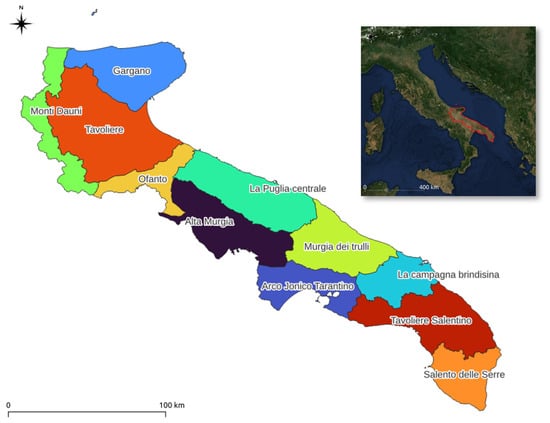
Figure 1.
Study area with the schematic division of the landscape “scopes” represented with different colours.
Agriculture is one of the most important sectors of the economy of Puglia. The region is particularly known for its olive trees and olive oil production [37]. Wheat, corn, potato, fruit, and vegetables are important products in Apulian agriculture. The crops are widespread everywhere but mainly in the Tavoliere area to the north. Products of animal origin are another important economic resource in Puglia. Cheese production is widespread in the region. Beef, pork, and sheep are also important in the zootechnics of Puglia, mainly in Murgia dei Trulli. Very important are also the cultivation of mussels in the areas of the Mar Piccolo and Laguna di Lesina [37].
There are many natural parks of environmental importance, including the Gargano National Park, the Reserve of Bosco Incoronata, the Reserve Saline di Margherita di Savoia, and the Regional Nature Reserve Bosco delle Pianelle, just to name a few. These nature parks are characterised by a wide range of natural habitats [38]. Thanks to its cultural and natural heritage, the region of Puglia is a very popular destination for tourists.
Finally, Puglia includes over 200 municipalities, among these the most populous being Bari, Brindisi, Taranto, Lecce, and Foggia.
2.2. Pesticide Analysis Methods
Several methods for the analysis of organic micropollutants, including pesticides, have been optimised over the last decade. Considering the wide variety of plant protection products on the market, refinement of traditional analysis techniques, including gas-cromatography (GC) and high-performance liquid chromatography (HPLC) with different types of detectors, has been observed over the years [39].
European regulations [40] have imposed very restrictive legal limits in the determination of active phytosanitary substances in water, to protect living beings and the environment. For this, it is often necessary to precede the instrumental analysis with techniques of preparation and concentration of the sample (liquid–liquid extraction, solid-phase extraction, solid-phase-microextraction) [9].
2.3. Nitrate Analysis Methods
Nitrate ions can be quantified using laboratory techniques, e.g., ion chromatography detection with the Metrohm 930 compact flex IC [41]. Nitrate detection can, also, be performed with in situ sensor-based methods. In the first case, it is an indirect determination method which allows high sensitivity and a good detection limit (LOD). However, it has the disadvantage of expensive instrumentation. In the second case, we refer to direct methods, such as those involving the use of biosensors. The latter is a viable alternative for in situ monitoring of nitrate ions with good data repeatability [42].
2.4. Quarry Mapping
A standard methodology was used to study mining activities in the Puglia region. The software used was Quantum GIS, a free and open-source geographic information system application [43]. The reference system used was the World Geodetic System 1984, EPSG:4326, of the global geodetic coordinate system. The base maps used for the identification of the sites were the orthophotos of the Puglia region. The time range used was from 2006 to 2019 (years 2006, 2010, 2013, 2016, 2019). For the analysis of the extractive zones of the territory, the database of the authorised quarries of the Puglia region was fundamental (provided by administrative offices). To facilitate the mapping of the regional area, a 3 km × 5 km grid was created. In this way, it was possible to analyse individually, at a more detailed scale, portions of territory for more representative results. A remapping of the previously mapped quarries was carried out, based on the most recent orthophotos, with vector typing tools in QGIS. New areas with clear evidence of mining activity have been mapped. The project has been implemented with various themes including the municipalities of Puglia, the official list of natural protected areas (EUAP), land use, and urbanised and other themes. This framing allowed us to have a full view of the area to be monitored and to obtain the perimeters of unauthorised quarries through the application of change detection techniques [44]. Through the activities of geoprocessing and overlay mapping, we have identified areas where the presence of excavation activities outside the known authorisation limits is evident. The areas thus identified have been saved in a geodatabase. It is important to note that the use of this methodology can provide a rough estimate of the extractive activities. Further investigations and verifications are needed for a complete and accurate assessment, as a field finding of remote data collected.
2.5. Further Data Sources and Metrics Implementation for the Evaluation of the Most Compromised Areas
We used additional information from regional databases by aggregating and normalising municipal data. Below, we explain the type and reasons for using them:
- cultivated hectares on municipal extension as a source of pesticides and plastics. The data come from the Corine Land Cover Project [45]; code 2 was used, i.e., agricultural areas. There are currently no perimeters of areas vulnerable to pesticides, so agricultural areas are a useful alternative source of information;
- perimeter delimitation of Nitrate Vulnerable Zones (NVZ) as a source of nitrate pollution of established agricultural origin [12];
- number of sites with waste and illegal dumps discovered and their extension as a source of pollution by metals, other pollutants, and plastics (confidential dataset);
- number of quarries and quarry extensions as a source of pollutants in the subsoil [4];
- the perimeter of protected areas, values of the intrinsic vulnerability of aquifers, and results of analytical monitoring of pesticides in Apulian water bodies as elements for discussion [9].
These data make it possible to carry out a qualitative assessment of the pressures on the water resource, also providing the cognitive elements for the identification of the protection and recovery measures aimed at guaranteeing the achievement or maintenance of the environmental objectives envisaged in the Water Framework Directive (WFD) [46]. Pressure assessment can be used to evaluate whether a specific element that varies causes an increase in specific pressure and therefore whether it is possible to intervene by defining guide criteria and identifying any prescriptions and measures to be implemented to reduce this pressure.
2.6. Cluster Analysis
To be able to compare the data from the different databases, we proceeded to normalise the values from 0 to 1 by dividing the value of each by the maximum value. In the case of sites subject to waste dumping and illegal dumping and quarrying, we normalised the coefficients of the average area extents by dividing the total extents of the sites by the number of them. With the normalised data, a cluster analysis was performed to identify subgroups of observations within a dataset. The aim was to identify as many different groups as possible that correspond to different observations. The method applied was k-means clustering, an unsupervised, machine-learning method for classifying subgroups. This method classifies records in such a way that objects within the same cluster are as similar as possible (high intra-class similarity), whereas objects in different clusters are as different as possible (low inter-class similarity). In k-means clustering, each cluster is represented by its centroid, which corresponds to the average of the points assigned to the cluster. Therefore, the total variation within clusters must be as low as possible. The algorithm for detection is from Hartigan–Wong (1979) [47], which defines the total variation within the cluster as the sum of the squared Euclidean distances between the elements and the corresponding centroid, according to the following:
with:
- V as total intra-cluster variation;
- xi as single record belonging to the k cluster;
- mk as the average value of the points assigned to the k cluster.
Each observation is therefore assigned to cluster k; thus, the sum of the squares of the distances of the observations from the centroids is minimal. Before running the algorithm, the number of clusters that will be generated must be identified and specified. This decision is usually made by the data analyst. To determine the optimal number of clusters for our purposes, we used the Elbow method [48]. Applying this method, we calculated the clustering algorithm for different values of k; for example, varying k from 1 to 10 clusters. For each value of k, the sum of the squares of the intra-cluster distances is calculated. The trend curve is drawn and the points where it breaks are observed.
3. Results
In the Puglia region, the mining activity represents about 10% compared to the national one; this depends mainly on the presence in the territory of economically important carbonate rocks for industry and construction.
There are three main extraction basins in the area: Apricena-Poggio Imperiale, in the northwestern sector of the region characterised by Mesozoic carbonate rocks; Trani-Bisceglie-Ruvo-Fasano, in the central sector with Cretaceous limestones; and Salento with the famous “Pietra Leccese”, in the south-western sector characterised by marly calcarenite. Extraction in the regional territory, in authorised sites, and production is mainly represented by limestone, clay, sand, and gravel [49]. The annual quantities (m3) by type of material extracted are 140,000 sand and gravel, 375,000 ornamental stones, 4,280,000 limestone, and 39,000 clay.
The mapping activity led to the identification of 7700 geometric polygons which identify quarries of various sizes in the regional territory, of which 3900 are or have been authorised while 271 have never been authorised. These sites are characterised by the fact that the concession limits have been exceeded with new excavation fronts or new quarries have been built in areas where it is not possible to do it. Therefore, this map was carried out by identifying those sites outside the authorised perimeters and which, sometimes, may also have disappeared, over time, because they were filled in (the nature of the materials is unknown to us). An example of a record identified through change detection is the one shown in Figure 2, in which the start of a quarry activity outside the authorised limits, in the period from 2006 to 2019 and the subsequent filling, is evident over the years.
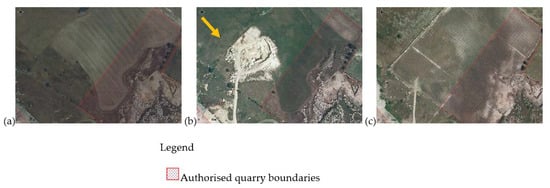
Figure 2.
Example of the result of the change detection in the period 2006–2019: (a) orthophoto of 2006; (b) orthophoto of 2010; (c) orthophoto of 2019. The orange arrow indicates a site considered, in our processing, as unauthorised.
Another sad phenomenon concerns the sites affected by uncontrolled waste abandonment. In these sites of various extensions, from punctiform sites to those of a few hectares, continuous abandonments of waste of various kinds occur over time because it is difficult for the authorities to keep this phenomenon under control with the men and means at their disposal. The ascertained data of these illegal dumps indicate the presence of about 2000 sites throughout the territory (some examples are shown in Supplementary Materials File S1).
Figure 3 shows the aggregate data of the number of sites currently active and already reclaimed by the province to represent the distribution of the phenomenon in the regional territory.
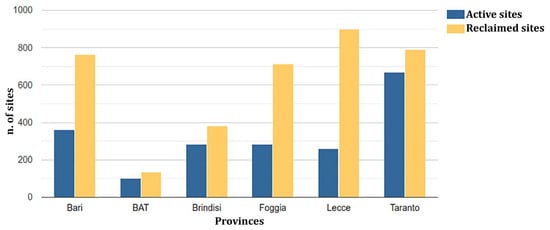
Figure 3.
Number of sites affected by waste abandonment and reclaimed by province.
In the whole regional territory, the cultivated hectares are 1,419,638, while the hectares identified as NVZ are 452,905. These areas are more concentrated in the Tavoliere delle Puglie area in the north of the region. Figure 4 shows a map with the cultivated areas of the Puglia region and with the areas identified as NVZ.
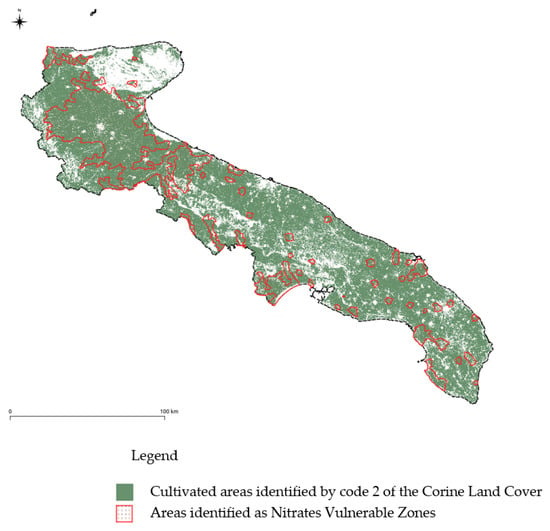
Figure 4.
Map of cultivated areas and areas identified as Nitrates Vulnerable Zones.
The data also made it possible to obtain a qualitative assessment of the pressures on water bodies. The pressures considered are those envisaged by the WFD [50]. This analysis allows us to identify a certain level of pressure on the water resources, which we have classified as low, medium, and high (Figure 5).
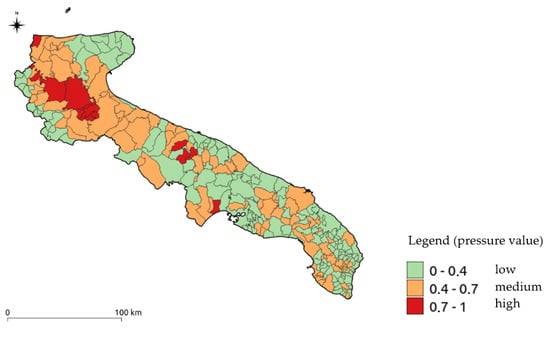
Figure 5.
Map of the normalised qualitative assessment of pressures on water resources.
This aspect is important as the monitoring programs are closely related to the pressures on water bodies for the selection of the quality elements to be monitored, i.e., the chemical, biological, and hydro-morphological ones, and therefore act as a useful decision-making tool to support the DSS.
Regarding the results of the cluster analysis, we first report those relating to the identification of the number of clusters (Figure 6). Looking at the curve obtained, the number of clusters to choose would range from two to five. Considering the territorial variability and the different databases used, by applying the value of two clusters, we would not give good emphasis to some aspects and processes taking place in the territory because we enclose too many variables in just two dimensions, while giving a value of five implies the creation of a number of clusters equal to the number of variables, and therefore, it would not make much sense. The value of four seems to us a good compromise to represent the different variables involved.
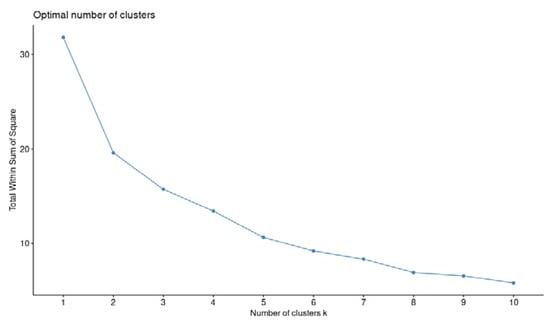
Figure 6.
Plot of intra-cluster variability according to the number of subgroups.
The results of the cluster analysis are shown in Figure 7. On the one hand, there is a certain overlapping of the clusters which represents an environmental continuity due to the situations present in different municipalities (this is normal), and on the other hand, each cluster is characterised by territorial peculiarities which allow us to easily identify the environmental contexts influencing the quality status of the environmental matrices, in particular the water resource. As previously explained, the clusters show a certain degree of overlap between them, which is expected since they are phenomena that do not have a clear solution of continuity. The clusters also show the presence of some points at the borders and are very detached from others and the centroid.
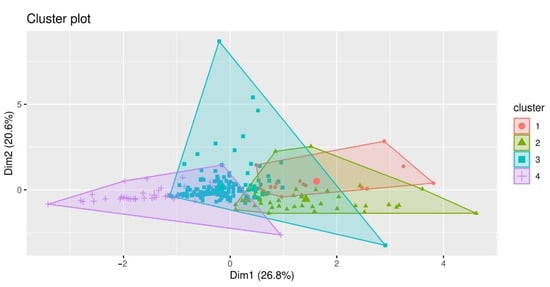
Figure 7.
Results of clustering of normalised data.
Subsequently, the number of the cluster was associated with the relative municipality and this allowed the representation of these values through the GIS system with a thematic map (Figure 8).
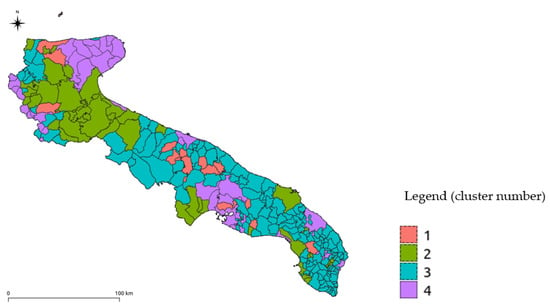
Figure 8.
Results of clustering implemented on the GIS system.
Finally, the values of the means of the normalised data relating to the clusters were compared to identify the driving forces that can explain the classification (Figure 9).
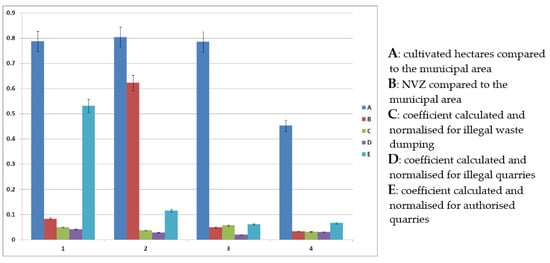
Figure 9.
Comparison of the averages of the normalised data relating to the identified clusters.
Non-overlapping values, identified by points, can be very spread out as in the case of clusters 1, 2, and 3 or can show some degree of linear continuity as in the case of cluster 4. Cluster 3 also shows a certain bidirectional variability, and some records completely cross the centre of the graph, positioning themselves both at the top and at the bottom, ranging from municipalities with intense tourist activity to others with a high presence of natural areas.
Clusters 1 and 2 are almost superimposable, which does not happen for some records, i.e., for municipalities characterised by intense mining activity. The normalised data of variable A appear to be significant only for the subdivision of clusters 1, 2, and 3 from cluster 4 and this confirms the previous deduction. Cluster 4 mainly includes municipalities with less agricultural activity and a greater zootechnical and tourist vocation. This cluster includes the municipalities belonging to various protected areas such as the Gargano National Park, the Valle d’Itria, and the sub-Appennino Dauno, known for their tourist vocation and production of local dairy and meat products.
The data produced by variable E identify cluster 1, while it is evident that variable B identifies cluster 2. Cluster 3 represents the most common state in which municipalities are, unfortunately, characterised by the highest value of parameter C (this is not a good sign for environmental protection). Only in cluster 4, these values are slightly lower, probably because there is greater attention to the territory to avoid a perception by tourists of abandoned and dirty territory.
4. Discussion
Aquatic ecosystems play a vital role in ecological balance and human well-being. However, pollution resulting from human activities is causing a significant depletion of the water resource and ecosystem services provided by these aquatic habitats [51,52,53,54,55]. Ecosystem services, i.e., the benefits humans derive from ecosystems, include, for example, the provision of drinking water, climate regulation, air purification, flood control, fishing, and tourism [56].
Pollution of water resources, vital for various ecosystem services, is mainly caused by human activities, such as industry, intensive agriculture, the use of fertilizers and pesticides, and incorrect or illegal waste disposal. These pollutants are released directly or indirectly into surface or groundwater, altering water quality and compromising aquatic ecosystems. Toxic chemicals, such as heavy metals and pesticides, can directly harm aquatic plants and animals, reducing their diversity and abundance [57,58,59]. This impact can interrupt food chains, influence ecological balances, and compromise the survival of species that play a key role in ecosystems.
Discharges of pollutants can lead to the destruction of aquatic vegetation, such as algae beds or macrophytes, which provide shelter, food, and breeding sites for many aquatic species; habitat loss can lead to declining populations of fish, waterfowl, and other organisms dependent on these habitats. Furthermore, the accumulation of harmful chemicals can make the water unsafe and unsuitable for human and animal use. Fisheries and aquaculture can be greatly affected by declining fish populations, while compromised water quality can make safe water supply and wastewater treatment difficult. Pollution can also negatively affect aquatic tourism, reducing the attractiveness of these destinations.
The problem of the diffusion of pollutants and above all their infiltration can be tackled and explored through data analysis with models that evaluate the information coming from the characteristics of the matrices and weather data to provide risk values for water resources.
Some hydrogeological models are useful to evaluate the state of water resources: hydrogeological models, water balance models, contaminant transport models, geomorphological models, and groundwater monitoring models.
A hydrogeological model is a mathematical and computational approach that integrates geological, hydrological, and hydrogeological data. This allows us to simulate and understand the flow of groundwater in a certain area. Water balance models [60] are used to quantify the balance between water inlets and outlets in a specific area. Contaminant transport models [61] can be used to study the dispersion and migration of contaminants into groundwater. Geomorphology models [62] can be used to understand the formation and evolution of karst systems. Groundwater monitoring models use real-time monitoring data to assess changes in groundwater quality and quantity. These models can be used to detect and monitor the effects of mining activities on water resources, including the influence of quarries on the surrounding aquifers. In addition, modelling approaches may vary depending on the specific geological and hydrogeological characteristics of the region of interest.
Hydrogeological models make it possible to predict the transport of pollutants in the aquifers over time and to predict possible contaminations in time and space, as well as to better identify critical situations through vulnerability assessment. In our case study, we compared the results of the cluster analysis with the intrinsic vulnerability values of the aquifers created according to the DRASTIC model [12,63]. (Figure 10).
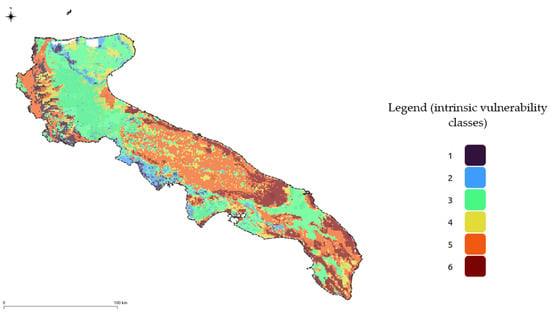
Figure 10.
Map of water intrinsic vulnerability according to DRASTIC methods: intrinsic vulnerability increases from 1 to 6.
Some significant aspects emerge when comparing the results of our classification relating to the normalised qualitative assessment of pressures on water resources with the latest data available by the Regional Agency for Environmental Protection (ARPA) Puglia for surface water bodies [64] and groundwater [65].
For surface water bodies, the picture is very critical in the areas of Tavoliere and Ofanto, as well as some areas west of the Tavoliere Salentino all identified in cluster 2, while other areas that today are subject to numerous pressure factors were in 2018 in a stationary state from an ecological point of view but worsening from a chemical point of view, such as the areas to the east and close to Mar Piccolo in the Arco Jonico Tarantino. From an ecological status point of view, the water bodies which are improving are almost all coastal marine (pp. 55–56, [66]).
For groundwater bodies, the “poor” chemical status of the water resource in the areas of the Tavoliere and Ofanto is confirmed, as well as in the areas of Arco Jonico Tarantino west of Mar Piccolo of Taranto. Patchy “poor” chemical status is also established in areas of the Tavoliere Salentino and in almost all the municipalities belonging to cluster 1. Water bodies that are in a “good” qualitative status are those of the Alta Murgia and in the southern area of the Tavoliere Salentino and central area of the Salento delle Serre (p. 48, [67]).
It should be noted that the recently published data refer to the 2016–2018 control period. The results reported by ARPA Puglia, if compared with those reported in the present methodology, indicate that the situation is worsening in the areas Tavoliere, Ofanto, Tavoliere Salentino, Arco Jonico Tarantino, and Puglia Centrale, while in other areas, there is a stationary state, except for coastal marine bodies in which the situation, from an ecological point of view, is improving.
Of course, this is symptomatic of the fact that some policies are succeeding while others are not. For example, the huge investments in the field of water treatment are bringing results while in the agricultural field, there is still a lot to do, as well as in the field of environmental controls on pollution from waste abandonment. In this regard, a vast regional action is about to be launched on the installation of hidden micro cameras in critical places whose images will be processed semi-automatically through machine learning.
Comparing the data of the results of the cluster analysis (Figure 8) with the values of intrinsic vulnerability (Figure 10) of the Puglia aquifers, it emerges that the areas of cluster 2 in the north of Puglia are located on less vulnerable aquifers, while those in the centre and south are on a more vulnerable aquifer: this implies that the risks of pollution and depletion of the groundwater deriving from agricultural activities are much greater in the latter areas. The municipalities belonging to cluster 1 seem to have the groundwater at greater risk especially if located in Puglia centrale, in the Alta Murgia, and partly in the Salento areas. These municipalities are precisely those characterised by a relatively greater number of quarries. In the areas present in cluster 4, there seem to be more critical issues for the municipalities of the Murgia dei trulli; in fact, compared to those of the Gargano, they are located on a more vulnerable aquifer with the risk of contamination by nitrates of zootechnical origin. As far as cluster 3 is concerned, the areas most at risk are those with higher vulnerability values: therefore, Puglia centrale with the southern Murgia and all of Salento.
To increase the levels of knowledge deriving from the information provided by these databases, the use of decision support systems induces considerable advantages: it is possible to have access to large amounts of data in real time, allowing decision-makers to make informed and timely decisions. For example, decision-makers could monitor the effects of the application of a monitoring program, assess whether there are environmental improvements, and better allocate resources for land management.
Precisely for this reason, we have preferred to carry out these elaborations based on the extensions of the municipal areas. Using the extensions of the river basins would create areas with an administrative management conflict, leading to a deadlock of improvement actions.
By automating data processing operations to obtain reports through programming scripts, we can leave much more time for decision-makers to focus on the most important decisions to be made.
The system also aims at minimizing the time required for drafting reports on the progress of the regional plans and programs of the individual different monitoring activities. In addition, decision support systems can use advanced algorithms and data analysis techniques to provide highly accurate and detailed information for site-specific purposes [68]. For example, it is possible to identify the factor limiting the growth in the well-being of the population of a given territory, the motivation why an area is not attractive from a tourist point of view based on elaborations on requests determined by particular needs.
On the other hand, decision support systems also have disadvantages. First of all, dependence on machines could lead decision-makers to neglect their intuition and personal experience. Furthermore, these systems are based on data and algorithms, and if there are errors in the latter, decisions could be compromised [69]. Sometimes decision support systems can require significant investments in terms of infrastructure, software, and qualified personnel. Furthermore, the process of implementing such systems can be very complex and require extensive staff training to be dedicated. Last but not least, we also mention the security risks: the collection and maintenance of sensitive data by decision support systems could expose it to security risks, such as data breaches.
5. Conclusions
Decision support systems can be very useful for administrators who wish to make informed and timely decisions on a regional scale.
In this case study, we reported how to implement a DSS based on the processing of environmental monitoring data at the municipal level. The created workflow is deliberately simple but this does not mean that it is unable to provide useful information on the status of some areas. The DSS can be applied on a regional scale to protect water resources, which are often subject to both punctual and widespread pollution events. The effort was to use available data coming from complex monitoring programs simply and immediately to offer valid information to decision-makers. The operational workflow represents a first step in monitoring the impacts on the environment and in particular on the water resource of some activities, both legal and illegal, on a regional scale.
Environmental pollution from pesticides, nitrates, heavy metals, and microplastics poses a threat to human health and the environment. To minimize these problems, there is a need for regulated management and the promotion of sustainable practices, such as the use of natural fertilisers, the reduction of pesticide use, and the reuse and recycling of waste. These practices could be adopted according to the specific territorial needs highlighted by this DSS.
As with any technology, however, there are also drawbacks to consider. To maximize the benefits of DSS, they should be implemented judiciously to ensure that decision-makers maintain a holistic view of the information and situation as they make important decisions.
Supplementary Materials
The following supporting information can be downloaded at: https://www.mdpi.com/article/10.3390/hydrology10080174/s1, File S1: Examples of sites with uncontrolled waste abandonment.
Author Contributions
Conceptualization, C.M. and V.F.U.; Methodology, C.M. and M.S.B.; Software, C.M. and M.S.B.; Formal analysis, C.M.; Resources, C.M.; Data curation, C.M., M.S.B. and M.T.; Writing—original draft, C.M., M.S.B. and M.T.; Writing—review & editing, C.M., M.S.B., M.T. and V.F.U.; Supervision, C.M.; Project administration, V.F.U.; Funding acquisition, C.M. and V.F.U. All authors have read and agreed to the published version of the manuscript.
Funding
This research was funded by the project “Monitoring Innovative Advanced—MIA Natura 2000 Network” POR—POC Puglia 2014–2020—Axis VI Action 6.5 Sub-Action 6.5.a—Procedure for the selection of monitoring actions of the Natura 2000 Network on habitats and species of Puglia (D.G.R. n. 150/2020 and D.G.R. n. 846 of 31.05.2021), by the project “Nitrates” financed by Puglia Department of Agriculture, Rural Development, and Environmental Protection (Water Resources section) and by the Collaboration Agreement between the Puglia region, the police forces, and IRSA-CNR for the monitoring of polluted sites.
Conflicts of Interest
The authors declare no conflict of interest.
References
- Veress, M. Karst Types and Their Karstification. J. Earth Sci. 2020, 31, 621–634. [Google Scholar] [CrossRef]
- Fiorillo, F.; Malik, P. Hydraulic Behavior of Karst Aquifers. Water 2019, 11, 1563. [Google Scholar] [CrossRef]
- Kalhor, K.; Ghasemizadeh, R.; Rajic, L.; Alshawabkeh, A. Assessment of Groundwater Quality and Remediation in Karst Aquifers: A Review. Groundw. Sustain. Dev. 2019, 8, 104–121. [Google Scholar] [CrossRef] [PubMed]
- Campanale, C.; Losacco, D.; Triozzi, M.; Massarelli, C.; Uricchio, V.F. An Overall Perspective for the Study of Emerging Contaminants in Karst Aquifers. Resources 2022, 11, 105. [Google Scholar] [CrossRef]
- Zioga, E.; Kelly, R.; White, B.; Stout, J.C. Plant Protection Product Residues in Plant Pollen and Nectar: A Review of Current Knowledge. Environ. Res. 2020, 189, 109873. [Google Scholar] [CrossRef]
- Bonanno, A.; Materia, V.C.; Venus, T.; Wesseler, J. The Plant Protection Products (PPP) Sector in the European Union: A Special View on Herbicides. Eur. J. Dev. Res. 2017, 29, 575–595. [Google Scholar] [CrossRef]
- Sun, S.; Sidhu, V.; Rong, Y.; Zheng, Y. Pesticide Pollution in Agricultural Soils and Sustainable Remediation Methods: A Review. Curr. Pollut. Rep. 2018, 4, 240–250. [Google Scholar] [CrossRef]
- Tang, F.H.M.; Lenzen, M.; McBratney, A.; Maggi, F. Risk of Pesticide Pollution at the Global Scale. Nat. Geosci. 2021, 14, 206–210. [Google Scholar] [CrossRef]
- Campanale, C.; Massarelli, C.; Losacco, D.; Bisaccia, D.; Triozzi, M.; Uricchio, V.F. The Monitoring of Pesticides in Water Matrices and the Analytical Criticalities: A Review. TrAC–Trends Anal. Chem. 2021, 144, 116423. [Google Scholar] [CrossRef]
- Lagzdiņš, A.; Jansons, V. Nitrate Monitoring Results in Agricultural Catchments. In Proceedings of the Annual 15th International Scientific Conference “Research for Rural. Development 2009”, Univ. Agric. Jelgava, Jelgava, Latvia, 20–22 May 2009; pp. 327–331. [Google Scholar]
- Losacco, D.; Ancona, V.; De Paola, D.; Tumolo, M.; Massarelli, C.; Gatto, A.; Uricchio, V.F. Development of Ecological Strategies for the Recovery of the Main Nitrogen Agricultural Pollutants: A Review on Environmental Sustainability in Agroecosystems. Sustainability 2021, 13, 7163. [Google Scholar] [CrossRef]
- Massarelli, C.; Losacco, D.; Tumolo, M.; Campanale, C.; Uricchio, V.F. Protection of Water Resources from Agriculture Pollution: An Integrated Methodological Approach for the Nitrates Directive 91/676/EEC Implementation. Int. J. Environ. Res. Public Health 2021, 18, 13323. [Google Scholar] [CrossRef] [PubMed]
- Akinnawo, S.O. Eutrophication: Causes, Consequences, Physical, Chemical and Biological Techniques for Mitigation Strategies. Environ. Chall. 2023, 12, 100733. [Google Scholar] [CrossRef]
- Smith, L.E.D.; Siciliano, G. A Comprehensive Review of Constraints to Improved Management of Fertilizers in China and Mitigation of Diffuse Water Pollution from Agriculture. Agric. Ecosyst. Environ. 2015, 209, 15–25. [Google Scholar] [CrossRef]
- Li, A.; Shi, Z.; Yin, Y.; Fan, Y.; Zhang, Z.; Tian, X.; Yang, Y.; Pan, L. Excessive Use of Chemical Fertilizers in Catchment Areas Raises the Seasonal PH in Natural Freshwater Lakes of the Subtropical Monsoon Climate Region. Ecol. Indic. 2023, 154, 110477. [Google Scholar] [CrossRef]
- Vryzas, Z. Pesticide Fate in Soil-Sediment-Water Environment in Relation to Contamination Preventing Actions. Curr. Opin. Environ. Sci. Health 2018, 4, 5–9. [Google Scholar] [CrossRef]
- Campanale, C.; Savino, I.; Pojar, I.; Massarelli, C.; Uricchio, V.F. A Practical Overview of Methodologies for Sampling and Analysis of Microplastics in Riverine Environments. Sustainability 2020, 12, 6755. [Google Scholar] [CrossRef]
- Issac, M.N.; Kandasubramanian, B. Effect of Microplastics in Water and Aquatic Systems. Environ. Sci. Pollut. Res. 2021, 28, 19544–19562. [Google Scholar] [CrossRef] [PubMed]
- Limoli, A.; Garzia, E.; De Pretto, A.; De Muri, C. Illegal Landfill in Italy (EU)—A Multidisciplinary Approach. Environ. Forensics 2019, 20, 26–38. [Google Scholar] [CrossRef]
- Massarelli, C. Fast Detection of Significantly Transformed Areas Due to Illegal Waste Burial with a Procedure Applicable to Landsat Images. Int. J. Remote Sens. 2018, 39, 754–769. [Google Scholar] [CrossRef]
- Biotto, G.; Silvestri, S.; Gobbo, L.; Furlan, E.; Valenti, S.; Rosselli, R. GIS, Multi-Criteria and Multi-Factor Spatial Analysis for the Probability Assessment of the Existence of Illegal Landfills. Int. J. Geogr. Inf. Sci. 2009, 23, 1233–1244. [Google Scholar] [CrossRef]
- Eyankware, M.O.; Akakuru, O.C. Appraisal of Groundwater to Risk Contamination near an Abandoned Limestone Quarry Pit in Nkalagu, Nigeria, Using Enrichment Factor and Statistical Approaches. Int. J. Energy Water Resour. 2022, 1–19. [Google Scholar] [CrossRef]
- Gu, J.D. Mining, Pollution and Site Remediation. Int. Biodeterior. Biodegrad. 2018, 128, 1–2. [Google Scholar] [CrossRef]
- Binetti, M.S.; Campanale, C.; Uricchio, V.F.; Massarelli, C. In-Depth Monitoring of Anthropic Activities in the Puglia Region: What Is the Acceptable Compromise between Economic Activities and Environmental Protection? Sustainability 2023, 15, 8875. [Google Scholar] [CrossRef]
- Green, J.A.; Pavlish, J.A.; Leete, J.H.; Alexander, E.C., Jr. Quarrying Impacts on Groundwater Flow Paths. In Sinkholes and the Engineering and Environmental Impacts of Karst; ASCE Library; American Society of Civil Engineers: Reston, VA, USA, 2003; pp. 216–222. [Google Scholar] [CrossRef]
- Ekmekci, M. Impact of Quarries on Karst Groundwater Systems. Digital Commons. KIP Articles 1990, 2617. Available online: https://digitalcommons.usf.edu/kip_articles/2617/ (accessed on 15 August 2023).
- Lemieux, J.M.; Therrien, R.; Kirkwood, D. Small Scale Study of Groundwater Flow in a Fractured Carbonate-Rock Aquifer at the St-Eustache Quarry, Québec, Canada. Hydrogeol. J. 2006, 14, 603–612. [Google Scholar] [CrossRef]
- Ozcan, O.; Musaoglu, N.; Seker, D.Z. Environmental Impact Analysis of Quarrying Activities Established on and near a River Bed by Using Remotely Sensed Data. Fresenius Environ. Bull. 2012, 21, 3147–3153. [Google Scholar]
- Castagna, S.; Dino, G.A.; Lasagna, M.; De Luca, D.A. Environmental Issues Connected to the Quarry Lakes and Chance to Reuse Fine Materials Deriving from Aggregate Treatments. In Engineering Geology for Society and Territory-Volume 5: Urban Geology, Sustainable Planning and Landscape Exploitation; Springer International Publishing: Cham, Switzerland, 2015; pp. 71–74. [Google Scholar] [CrossRef]
- Poulain, A.; de Dreuzy, J.R.; Goderniaux, P. Pump Hydro Energy Storage Systems (PHES) in Groundwater Flooded Quarries. J. Hydrol. 2018, 559, 1002–1012. [Google Scholar] [CrossRef]
- Massarelli, C.; Matarrese, R.; Uricchio, V.F.; Muolo, M.R.; Laterza, M.; Ernesto, L. Detection of Asbestos-Containing Materials in Agro-Ecosystem by the Use of Airborne Hyperspectral CASI-1500 Sensor Including the Limited Use of Two UAVs Equipped with RGB Cameras. Int. J. Remote Sens. 2017, 38, 2135–2149. [Google Scholar] [CrossRef]
- Çavus, A.; Şen, F. Development of a Water Quality Index for Lake Aygır in Bitlis, Turkey. Mar. Sci. Technol. Bull. 2022, 11, 187–193. [Google Scholar] [CrossRef]
- Khan, I.; Zakwan, M.; Pulikkal, A.K.; Lalthazula, R. Impact of Unplanned Urbanization on Surface Water Quality of the Twin Cities of Telangana State, India. Mar. Pollut. Bull. 2022, 185, 114324. [Google Scholar] [CrossRef]
- Schweitzer, L.; Noblet, J. Water Contamination and Pollution. Green Chem. An Incl. Approach 2018, 261–290. [Google Scholar] [CrossRef]
- Power, D.J. A Brief History of Decision Support Systems. Available online: http://dssresources.com/history/dsshistory.html (accessed on 27 June 2023).
- Plunge, S.; Gudas, M.; Povilaitis, A. Effectiveness of Best Management Practices for Non-Point Source Agricultural Water Pollution Control with Changing Climate–Lithuania’s Case. Agric. Water Manag. 2022, 267, 107635. [Google Scholar] [CrossRef]
- Lo Giudice, V.; Faraone, I.; Bruno, M.R.; Ponticelli, M.; Labanca, F.; Bisaccia, D.; Massarelli, C.; Milella, L.; Todaro, L. Olive Trees By-Products as Sources of Bioactive and Other Industrially Useful Compounds: A Systematic Review. Molecules 2021, 26, 5081. [Google Scholar] [CrossRef] [PubMed]
- Massarelli, C.; Campanale, C. Climatic, Bioclimatic, and Pedological Influences on the Vegetation Classification of “Bosco Dell’Incoronata” in Southern Italy. Rend. Lincei 2023, 34, 537–552. [Google Scholar] [CrossRef]
- Campanale, C.; Triozzi, M.; Massarelli, C.; Uricchio, V.F. Development of a UHPLC-MS/MS Method to Enhance the Detection of Glyphosate, AMPA and Glufosinate at Sub-Microgram/L Levels in Water Samples. J. Chromatogr. A 2022, 1672, 463028. [Google Scholar] [CrossRef] [PubMed]
- European Union. European Parliament Directive 2009/90/EC of the European Parliament and of the Council. Off. J. Eur. Union 2009, 5, 36–38. [Google Scholar]
- Losacco, D.; Tumolo, M.; Cotugno, P.; Leone, N.; Massarelli, C.; Convertini, S.; Tursi, A.; Uricchio, V.F.; Ancona, V. Use of Biochar to Improve the Sustainable Crop Production of Cauliflower (Brassica oleracea L.). Plants 2022, 11, 1182. [Google Scholar] [CrossRef]
- Alahi, M.E.E.; Mukhopadhyay, S.C. Detection Methods of Nitrate in Water: A Review. Sens. Actuators A Phys. 2018, 280, 210–221. [Google Scholar] [CrossRef]
- QGIS. Available online: https://www.qgis.org/en/site/about/index.html (accessed on 9 June 2023).
- Massarelli, C.; Basile, A.; Uricchio, V.F.; Campobasso, G.; Netti, G. Comparative Evaluation of Change Detection Techniques Applied to the Detection of Areas Affected by Landfills. In Proceedings of the ASITA, Florence, Italy, 14–16 October 2014; pp. 831–839. [Google Scholar]
- CORINE Land Cover—Copernicus Land Monitoring Service. Available online: https://land.copernicus.eu/pan-european/corine-land-cover (accessed on 29 June 2023).
- European Parliament Directive 2000/60/EC of the European Parliament and of the Council. Available online: https://eur-lex.europa.eu/legal-content/EN/TXT/?uri=CELEX:32000L0060 (accessed on 31 July 2023).
- Hartigan, J.A.; Wong, M.A. A K-Means Clustering Algorithm. J. R. Stat. Soc. Ser. C Appl. Stat. 1979, 28, 100–108. [Google Scholar] [CrossRef]
- Marutho, D.; Hendra Handaka, S.; Wijaya, E. Muljono The Determination of Cluster Number at K-Mean Using Elbow Method and Purity Evaluation on Headline News. In Proceedings of the 2018 International Seminar on Application for Technology of Information and Communication, Semarang, Indonesia, 21–22 September 2018; pp. 533–538. [Google Scholar] [CrossRef]
- National Institute of Statistics Istat. It Attività Estrattive. Available online: https://www.istat.it/it/archivio/attività+estrattive (accessed on 26 June 2023).
- European Environmental Agency. Surface Water Significant Pressures and Impacts. Available online: https://water.europa.eu/freshwater/data-maps-and-tools/water-framework-directive-surface-water-data-products/significant-pressures-and-impacts (accessed on 5 August 2023).
- Ji, S.; Ma, S. The Effects of Industrial Pollution on Ecosystem Service Value: A Case Study in a Heavy Industrial Area, China. Environ. Dev. Sustain. 2022, 24, 6804–6833. [Google Scholar] [CrossRef]
- Kumar, R.; Verma, A.; Shome, A.; Sinha, R.; Sinha, S.; Jha, P.K.; Kumar, R.; Kumar, P.; Shubham; Das, S.; et al. Impacts of Plastic Pollution on Ecosystem Services, Sustainable Development Goals, and Need to Focus on Circular Economy and Policy Interventions. Sustainability 2021, 13, 9963. [Google Scholar] [CrossRef]
- Briffa, J.; Sinagra, E.; Blundell, R. Heavy Metal Pollution in the Environment and Their Toxicological Effects on Humans. Heliyon 2020, 6, e04691. [Google Scholar] [CrossRef]
- Bijay-Singh, C.E.; Craswell, E. Fertilizers and Nitrate Pollution of Surface and Ground Water: An Increasingly Pervasive Global Problem. SN Appl. Sci. 2021, 3, 1–24. [Google Scholar] [CrossRef]
- de Vries, W. Impacts of Nitrogen Emissions on Ecosystems and Human Health: A Mini Review. Curr. Opin. Environ. Sci. Health 2021, 21, 100249. [Google Scholar] [CrossRef]
- Lamarque, P.; Quétier, F.; Lavorel, S. The Diversity of the Ecosystem Services Concept and Its Implications for Their Assessment and Management. Comptes Rendus Biol. 2011, 334, 441–449. [Google Scholar] [CrossRef] [PubMed]
- Tchounwou, P.B.; Yedjou, C.G.; Patlolla, A.K.; Sutton, D.J. Heavy Metal Toxicity and the Environment. EXS 2012, 101, 133–164. [Google Scholar] [CrossRef]
- Van Der Werf, H.M.G. Assessing the Impact of Pesticides on the Environment. Agric. Ecosyst. Environ. 1996, 60, 81–96. [Google Scholar] [CrossRef]
- Barata, C.; Damasio, J.; Lopez, M.A.; Kuster, M.; Lopez, M.; Barcelo, D.; Riva, C.; Raldua, D. Combined Use of Biomarkers and in Situ Bioassays in Daphnia Magna to Monitor Environmental Hazards of Pesticides in the Field. Environ. Toxicol. Chem. 2007, 26, 370–379. [Google Scholar] [CrossRef] [PubMed]
- Abdollahi, K.; Bazargan, A.; McKay, G. Water Balance Models in Environmental Modeling. Handb. Environ. Mater. Manag. 2019. [Google Scholar] [CrossRef]
- MODFLOW Instructional Manual|US EPA. Available online: https://www.epa.gov/water-research/modflow-instructional-manual (accessed on 27 June 2023).
- Baker, V.R. The Modern Evolution of Geomorphology—Binghamton and Personal Perspectives, 1970–2019 and Beyond. Geomorphology 2020, 366, 106684. [Google Scholar] [CrossRef]
- Aller, L.; Lehr, J.; Petty, R.; Bennett, T. Drastic: A Standardized System to Evaluate Groundwater Pollution Potential Using Hydrogeologic Setting. J. Geol. Soc. India 1987, 455. [Google Scholar]
- Regional Agency for the Prevention and Protection of the Environment Regional Agency for the Prevention and Protection of the Environment—Quality of Surface Water Bodies and Coastal Marine Environment. Inland Waters. Available online: https://www.arpa.puglia.it/pagina3374_qualit-dei-corpi-idrici-superficiali-e-ambiente-marino-costiero-acque-interne.html (accessed on 31 July 2023).
- Environment, R.A. For the Prevention and Protection of the Regional Agency for the Prevention and Protection of the Environment—Groundwater Bodies Report. Available online: https://www.arpa.puglia.it/pagina3367_report-corpi-idrici-sotterranei.html (accessed on 31 July 2023).
- Regional Agency for the prevention and protection of the environment Proposal for Classification of Surface Water Bodies 2016–2018. Report n. 2/2022. UOC Natural Environments. ARPA Puglia. Bari. Available online: https://www.arpa.puglia.it/moduli/output_immagine.php?id=5440 (accessed on 15 August 2023).
- Regional Agency for the prevention and protection of the environment Proposal for Classification of Groundwater Bodies 2016–2018 Report n. 1/2020 “Progetto Maggiore”. ARPA Puglia. Bari. Available online: https://www.arpa.puglia.it/moduli/output_immagine.php?id=5440 (accessed on 15 August 2023).
- Sarker, I.H. Machine Learning: Algorithms, Real-World Applications and Research Directions. SN Comput. Sci. 2021, 2, 160. [Google Scholar] [CrossRef]
- Brain, D.; Webb, G.I. The Need for Low Bias Algorithms in Classification Learning from Large Data Sets. Lect. Notes Comput. Sci. (Incl. Subser. Lect. Notes Artif. Intell. Lect. Notes Bioinform.) 2002, 2431, 62–73. [Google Scholar] [CrossRef]
Disclaimer/Publisher’s Note: The statements, opinions and data contained in all publications are solely those of the individual author(s) and contributor(s) and not of MDPI and/or the editor(s). MDPI and/or the editor(s) disclaim responsibility for any injury to people or property resulting from any ideas, methods, instructions or products referred to in the content. |
© 2023 by the authors. Licensee MDPI, Basel, Switzerland. This article is an open access article distributed under the terms and conditions of the Creative Commons Attribution (CC BY) license (https://creativecommons.org/licenses/by/4.0/).